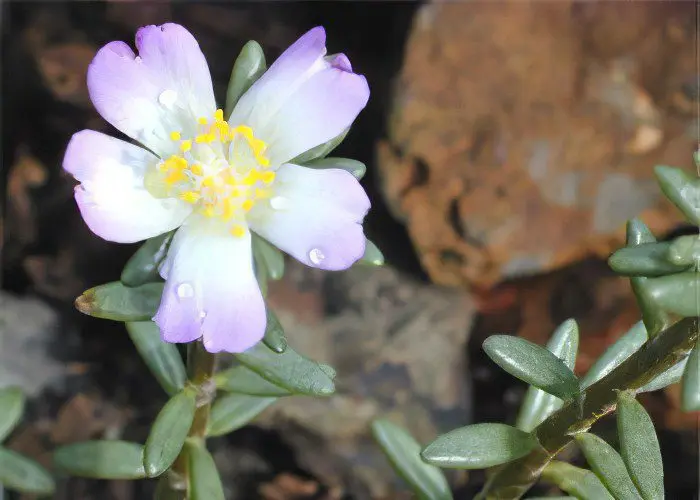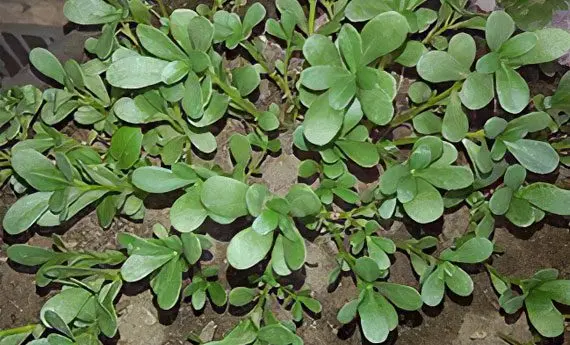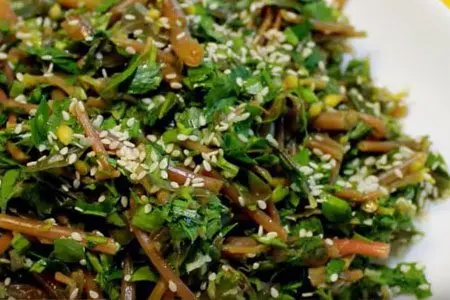
purslane – an annual plant, characterized by fleshy, opposite, oblong, thick leaves and branched, sometimes recumbent ascending and erect stems. Yellow flowers of small size are collected in bunches. The fruit is spherical or ovoid, dark brown seeds ripen in it. The plant blooms from June to September. Purslane lives on deposits, wastelands, in river valleys. Places of its growth – Russia, the North Caucasus. Purslane is grown by gardeners as a vegetable.
This annual plant is found in abundance in household plots and wastelands in southern Russia. The tradition of using purslane as a medicinal plant dates back to the times of Hippocrates and Pliny. These great healers recommended its use to the elderly and debilitated patients, as well as to those who are recovering from a serious injury. Arabic poetry of the Middle Ages praised purslane, calling it the “blessed herb” for its unique medicinal properties.
Snake and insect bites, sleep disturbances and beriberi, intestinal disorders and liver disease – the widest range of use of purslane as a healing agent has made it a very important culture. Purslane was not left in Russia either – in the diet of the inhabitants of monasteries it was used as a means to reduce potency, and also contributed to the healing of wounds, relieved inflammation. In addition, it turned out that purslane also has culinary advantages. Its sour-tart taste still complements the bouquet of some dishes of French and Armenian cuisine. Purslane is used in salads and hot dishes, pickles and marinades are prepared from it, in no way inferior to delicacy capers.

Useful properties of purslane
The healing properties of purslane have been used since ancient times, Hippocrates recommended this plant for many diseases. Its benefits are truly endless. Juicy greens contain vitamins of group A, combining substances with a common biological effect. Vitamins of groups B, K, PP, E are present in the plant.
Thanks to the organic acids present in the plant, normal metabolic processes in the body are preserved. The use of a medicinal plant contributes to the saturation of organs and systems with salts of calcium, potassium, magnesium, etc. The leaves contain vitamin C, carotene, flavonoids. Purslane is an excellent supplier of mucous and resinous substances.
In medicine, purslane has found application to get rid of headaches, coughs, arthritis, in the treatment of problems of the gastrointestinal tract, liver, shortness of breath.
Means based on purslane are prescribed for:
Muscle relaxation.
Softening and healing of the skin with psoriasis, weeping wounds.
Gentle bowel cleansing.
Relief of symptoms of inflammation.
Myocardial recovery.
diuretic effect.
Detoxification after insect bites, snakes.
Improvement of the oral cavity with stomatitis, periodontal disease, tonsillitis.
Recent studies by scientists have proven that purslane has a therapeutic effect in psoriasis, and also restores bone density in osteoporosis.
The study of the composition of purslane gave unexpected results. It turned out that the nutritional value of the plant is not inferior to the main vegetables that we are used to seeing on the table. Purslane has a high concentration of vitamin C, beta-carotene, alpha-linolenic acid [1].
Nutrient and antioxidant compounds explain the high energy value of this seemingly unremarkable plant. [2].
The concentration of nutrients and the medicinal properties of purslane are influenced by the growing conditions, variety and period of collection of the plant. [3].
In traditional Chinese medicine, purslane is used in the complex treatment of diabetes mellitus and hypertension. No special studies have been conducted on the antidiabetic effectiveness of purslane, but this has not affected its popularity among people with diabetes. However, with the participation of animals, laboratory experiments were carried out. One study found that raw purslane polysaccharides could have a hypoglycemic effect in sick rodents. [4].
Rich in vitamin A. Purslane has a pronounced antioxidant effect due to the high level of vitamin A. Its level in purslane is the highest among all green leafy vegetables. This vitamin compound has a positive effect on vision, heals the mucous membranes, protects the oral cavity and lungs from oncological processes.
Purslane contains high concentrations of vitamin C, B vitamins (riboflavin, niacin, pyridoxine), magnesium, calcium, phosphorus and iron.
Source of omega-3. Purslane has long been considered one of the best sources of plant-based omega-3 fatty acids. Its active components are able to influence the level of total cholesterol, triglycerides. Along with a decrease in “bad” cholesterol, purslane increases the indicators of “good” – high density lipoproteins.
The ability of omega-3 acids to reduce blood viscosity is known, which is very important in the presence of problems with blood vessels. Regular fish oil contains a certain proportion of cholesterol and calories. In purslane, cholesterol is completely absent, and only 100 calories per 20 g of fresh herbs.
Among all types of purslane, green, golden, large-leaved golden are distinguished. Each of the plant varieties contains vegetable omega-3 acids and prevents the development of heart disease, various types of cancer [5].
For maximum benefit in terms of sufficient omega-3 acids and minerals, purslane is consumed like green leafy vegetables. [6].
Vegetable fatty acids are an essential component necessary for the synthesis of hormones. With their help, the body throughout its life is protected from malignant degeneration of tissues, diseases of the heart and blood vessels, chronic inflammatory processes. A number of enzymes present in omega-3s help maintain nutrient homeostasis in tissues.
Compared to spinach, purslane contains several times more valuable amino acids, vitamins, and ascorbic acid. In terms of valuable fatty acids, it surpasses linseed oil.
Chemical composition
Calories 16 KKal
- Fats:
0,1 g
- Proteins:
1,3 g
- Carbohydrates:
3,4 g
- Water:
93,8 g
- Ash:
1,4 g
- Cellulose:
n⁄d
Vitamins and fats | Quantity | % RDN |
Omega-3 | 900 mg | 82% |
Vitamin A (retinol) | 396 mcg | 44% |
Vitamin C (ascorbic acid) | 21 mg | 23% |
Vitamin B2 (riboflavin) | 0,112 mg | 9% |
Vitamin B6 (pyridoxine) | 0,073 mg | 6% |
Vitamin B1 (thiamine) | 0,047 mg | 4% |
Vitamin B3 (PP, nicotinic acid) | 0,480 mg | 3% |
Vitamin B9 (folic acid) | 12 mcg | 3% |
Minerals (in 100 g): | Quantity | %RDN |
Hardware | 1,99 mg | 25% |
Magnesium | 68 mg | 17% |
Manganese | 0,30 mg | 13% |
Copper | 0,11 mg | 13% |
Calcium | 65 mg | 7% |
Phosphorus | 44 mg | 6% |
Selenium | 0,9 mg | 2% |
[Video] Purslane – food, healer, hormone of happiness and joy:
Vegetable salad with purslane

If you want to enrich your diet or surprise your guests, prepare a salad of vegetables and purslane. To prepare a nutritious and healthy meal you will need:
300-400 grams of purslane leaves, separated from the stems.
100 grams of canned corn.
100 grams of red onion, cut into thin rings.
2 eggs.
1 large tomato.
Salt, pepper to taste. Instead of regular table salt, you can use sea salt.
2 tablespoons of any vegetable oil (walnut, olive, sunflower, linseed).
Purslane leaves are thoroughly washed, dried with a towel, large ones are cut. Hard-boiled eggs are chopped with a knife, the onion is cut into thin rings, the tomato is cut into large pieces or slices. All ingredients are mixed in a salad bowl. Salt and pepper are added to taste. The finished salad is seasoned with vegetable oil and immediately served at the table.
[Video] Purslane salad recipe:









